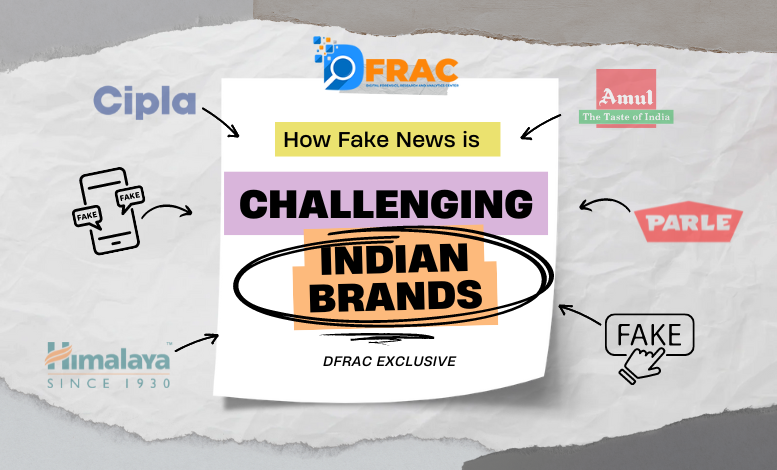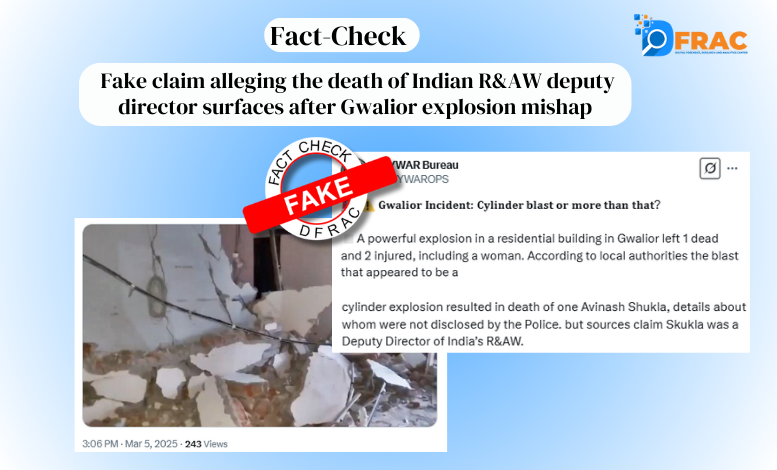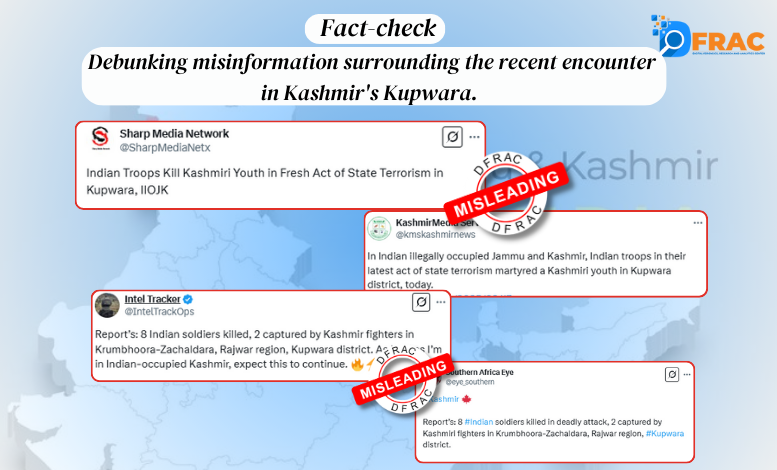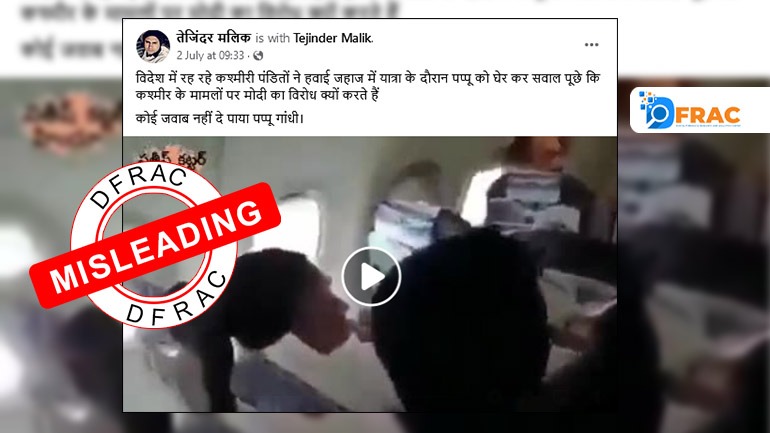Introduction
In the digital age, brands are not just battling market competition—they are also grappling with the pernicious spread of fake news. For Indian companies, the rise of misinformation has become a formidable threat, capable of tarnishing reputations and undermining consumer trust almost overnight. As social media platforms become the epicentre of public discourse, they have also become fertile ground for the rapid dissemination of falsehoods. This report explores the impact of fake news on the sales and brand value of Indian companies, drawing insights from various case studies and industry analyses. It also examines how brands respond to such misinformation and the strategies they adopt to mitigate these challenges.
Let’s unroll:
- Types of Fake News Targeting Brands
- Case Studies: The Impact of Fake News on Indian Brands
- DFRAC Case Study: The Controversy Surrounding Halal Products in India
- Strategies of Brands to Tackle Misinformation
Types of Fake News Spread About Brands
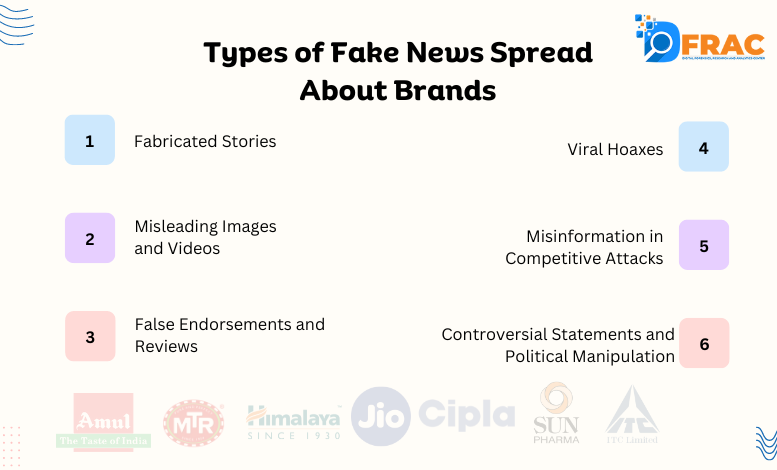
Fake news affecting brands can manifest in various forms, each with distinct characteristics and consequences. Some common types include:
1. Fabricated Stories
These are entirely false narratives created to deceive the public. They often appear as news articles, social media posts, or blog entries, presenting misleading information about a brand’s products, policies, or practices. Fabricated stories can significantly damage a brand’s reputation by planting seeds of doubt and mistrust among consumers.
2. Misleading Images and Videos
Visual content, such as manipulated images or videos, can be highly convincing and spread rapidly across social media platforms. These visuals often portray a brand’s products or services negatively, leading to consumer scepticism and aversion. A notable example is the Amul milk video, which falsely depicted spoiled milk, causing widespread concern among consumers.
3. False Endorsements and Reviews
Fake endorsements by celebrities or industry experts, as well as fabricated customer reviews, can influence public perception and purchasing decisions. Brands may be portrayed as either overwhelmingly positive or negative, skewing consumer opinions and distorting market competition. This type of fake news can erode trust in the brand and diminish its credibility.
4. Viral Hoaxes
Viral hoaxes are sensational claims that rapidly gain traction on social media, often leading to widespread panic or outrage. These hoaxes can range from false product recalls to exaggerated claims about a brand’s business practices. They often target a brand’s core values, attempting to undermine its integrity and consumer trust.
5. Misinformation in Competitive Attacks
Competitors or other malicious entities may spread false information to tarnish a brand’s image and gain a competitive advantage. These attacks can include fake news about a brand’s financial instability, unethical practices, or product failures. Such misinformation can lead to decreased consumer confidence and market share.
6. Controversial Statements and Political Manipulation
Brands can become victims of fake news that leverages political or social issues to incite backlash. This type of misinformation often involves taking brand statements or actions out of context to create controversy and polarize public opinion.
Case Studies: The Impact of Fake News on Indian Brands
Parle: Fake News Incident
Parle, one of India’s iconic biscuit brands, faced a wave of fake news alleging that the company was planning to lay off 10,000 employees. Additionally, images of a supposed new product called “Dark Parle-G” biscuits were circulated on social media, causing confusion among consumers.
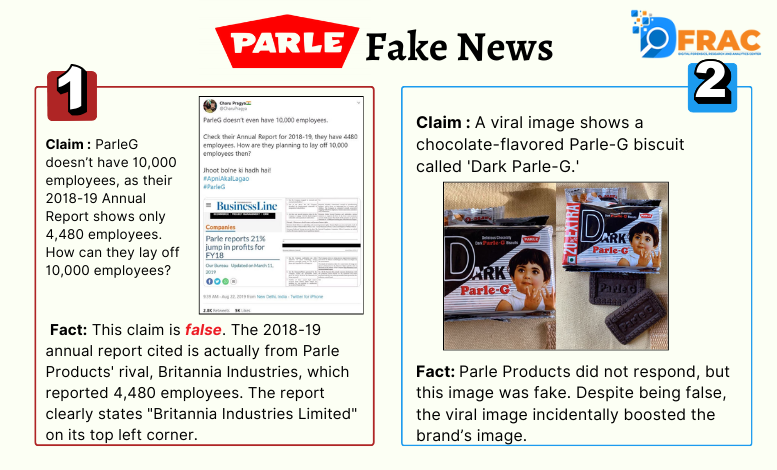
Cipla: Recruitment Fraud and Counterfeit Drug Allegations
Cipla, a leading pharmaceutical company, was targeted with false information regarding fraudulent recruitment schemes and allegations of counterfeit drugs being distributed under its brand name.
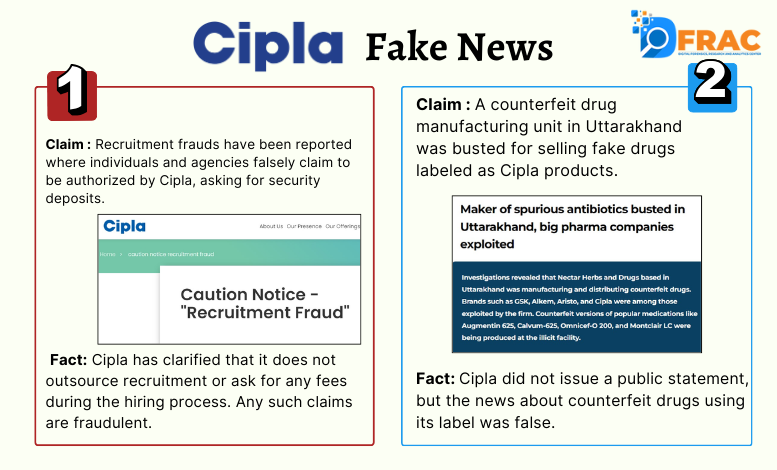
Amul: Fake News Related to Product Quality and AI-Generated Images
Amul, a leading dairy brand in India, faced several instances of fake news, particularly related to the quality of its products. Additionally, AI-generated images circulated on social media, creating controversies and raising unwarranted concerns about the brand.
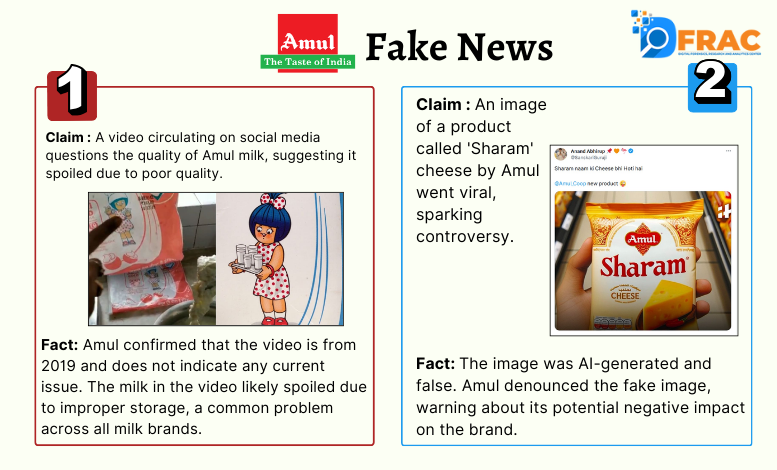
Cadbury: Fake News Incident
Cadbury is a renowned confectionery brand known for its wide range of chocolate products. With a rich history dating back to 1824, Cadbury has become a household name in many countries, including India. However, it was also targeted by Fake News about the products being Halal.
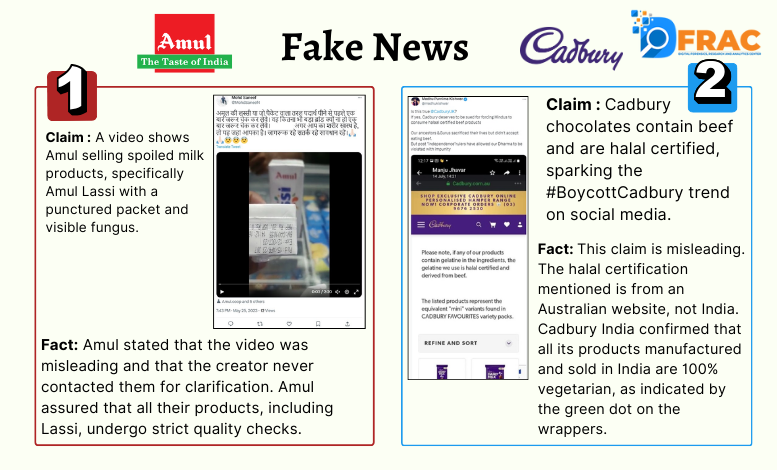
Himalaya: Frequent Target of Fake News
Himalaya is a leading global healthcare brand specialising in herbal and natural products. Founded in 1930, the company offers a wide range of products, including pharmaceuticals, personal care items, and wellness solutions, all rooted in Ayurvedic principles. However, the company has been targeted frequently by Multiple fake news about it’s products or Owner.
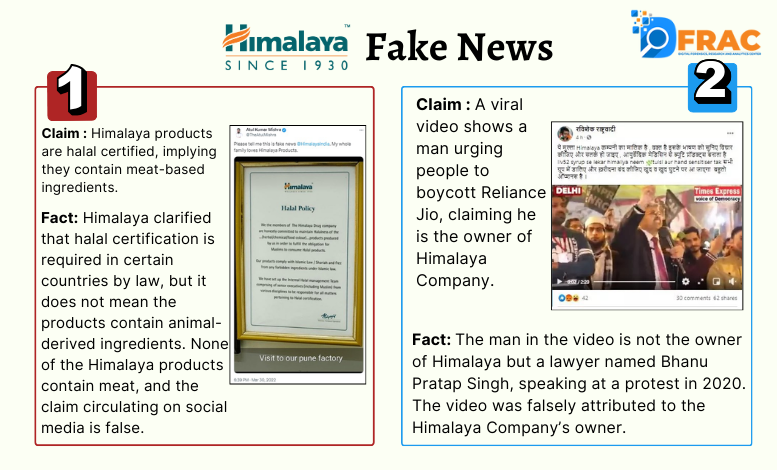
Jio: Tangled in Financial Fake News
Reliance Jio is a telecommunications giant in India, offering a range of services including mobile telephony, broadband, and digital services. However, it was also not spared from being targeted by Fake news.
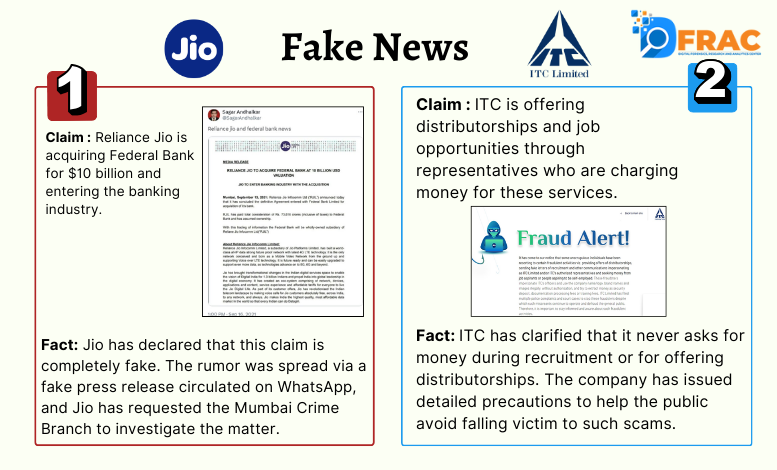
ITC: Fake Distributorship Offers and Recruitment Scams
ITC, a diversified conglomerate, was plagued by misinformation involving fake distributorship offers and fraudulent recruitment schemes. These scams targeted aspiring entrepreneurs and job seekers, luring them with promises of lucrative deals and employment opportunities.
MTR: Halal and Fake News
MTR Foods is an established Indian brand known for its packaged foods and instant mixes, rooted in traditional South Indian cuisine. With a history dating back to 1924, MTR has grown to become a trusted name in the Indian food industry, offering a wide range of ready-to-eat meals, spices, and mixes that cater to modern consumers. However, like other food companies, it was also targeted with Halal Fake news.

Sun Pharma
Sun Pharmaceutical Industries is one of India’s largest pharmaceutical companies, providing high-quality, affordable medicines across the globe. Founded in 1983, the company has a strong presence in both generic and speciality medicines, with a focus on innovation and patient care.
DFRAC Case Study: Controversy Surrounding Halal Products in India
Background
In the wake of the hijab controversy, another significant social media controversy emerged in India, centred around the boycott of halal-certified products. This movement targeted several prominent brands, including Himalaya and Haldiram, among others. The controversy was fueled by allegations that these companies’ halal certification practices were discriminatory against non-Muslims, leading to widespread calls for boycotts. The controversy quickly gained traction on social media, with several hashtags becoming trending topics.
Fake News
A significant component of the controversy was the spread of fake and misleading information related to halal certification:
- Himalaya: One of the primary targets, Himalaya, faced a fake news claim that their Neem and Tulsi capsules used halal-certified meat. A screenshot from a 2015 email was circulated, suggesting that the capsules contained bovine bone gelatin certified as halal. However, Himalaya clarified that none of their products contain meat and that the capsules in question were reformulated years ago to use vegetable capsules, debunking the false claims.
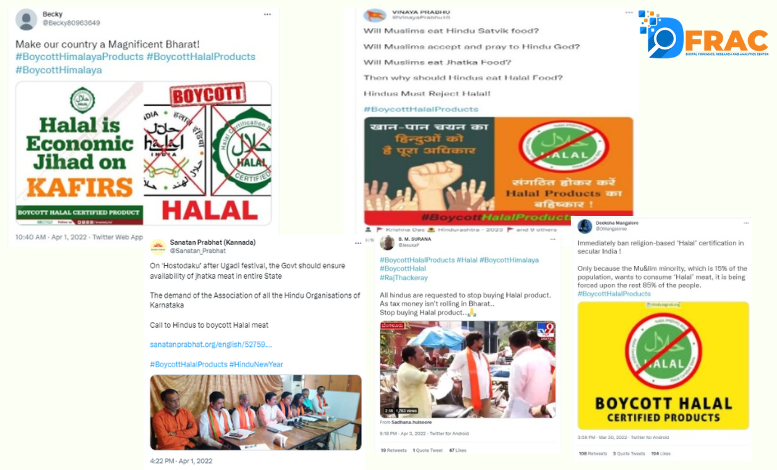
- Lucky Ali: Another instance of misinformation involved a viral post falsely attributing a statement to singer Lucky Ali, claiming that halal meat is not for non-Muslims. This post was misleading, as Lucky Ali’s original statement was intended to clarify the economic reasoning behind halal certification, not to promote religious exclusivity.

Rise of Hashtags
The controversy led to a surge in various hashtags that called for the boycott of halal-certified products. Some of the most prominent hashtags included:
- #BoycottHalalProducts
- #BanHalal
- #BoycottHimalaya
- #BoycottHaldirams
- #RadicalIslamicTerrorism
The hashtag #BoycottHimalaya gained significant momentum, peaking on April 1, 2022, with more than 2,500 tweets and 550 replies. Shortly after, #BoycottHaldirams also trended, reaching its peak on April 6, 2022, with over 2,500 tweets and 600 replies.

People Mentioned
Several high-profile individuals and accounts played a key role in amplifying these trends:
- @CTRavi_BJP: A politician who tweeted against halal products, framing the issue as “economic jihad.”
- @SherlynChopra: An actress who questioned why halal products were being forced on non-Muslims.
- @madhukishwar: A public figure who expressed concerns about consuming products from halal-compliant companies like Himalaya, suggesting they might be involved in “Thook Jihad.”
The accounts of companies like @HimalayaIndia and other influential figures such as @SirPareshRawal were also frequently mentioned in these tweets.

It is seen that #BoycottHaldirams hashtag was also done Aug 5, 2016. Whereas, hashtags on Boycott Himalaya started from Mar 15, 2020.
Impact
The spread of fake news and the rise of boycott hashtags had a significant impact on the targeted brands. The controversy not only tarnished the reputations of companies like Himalaya and Haldiram but also highlighted the growing influence of social media in shaping public opinion. The movement led to a polarization of consumer sentiments, with some users actively participating in the boycott while others defended the targeted companies. The impact extended beyond the brands themselves, as the controversy fueled religious and communal tensions within the country on internet.
DFRAC Analysis
The DFRAC report provided an in-depth analysis of the tactics and strategies employed in the Boycott and Halal campaign, shedding light on the mechanisms through which fake news can effectively damage a brand’s reputation. Key insights include:
- Viral Hashtags: The strategic use of viral hashtags helped the misinformation campaign gain momentum, reaching a wide audience and fostering public engagement.
- Influencer Involvement: Prominent influencers and public figures contributed to spreading the fake news, lending credibility to the misinformation and increasing its impact.
- Emotional Appeal: The campaign effectively tapped into emotional triggers, using sensational claims and provocative imagery to evoke strong reactions from the public.
We encountered the types of Fake news affecting the brands, let’s understand the reactionary part from the brands to tackle the misinformation.
Strategies of Brands to Tackle Misinformation
In the face of fake news and misinformation, companies must adopt a multi-faceted approach to safeguard their reputation and maintain consumer trust. The following strategies are commonly employed by brands to address misinformation:
1. Public Clarifications and Statements
- Issuing Public Statements: Companies often release official statements to clarify the misinformation and provide accurate information to the public. This immediate response helps to counteract the spread of fake news and reassure consumers.
- Example: Parle promptly issued clarifications when false reports about their products circulated on social media, addressing the misinformation head-on.
- Example: Cipla and Sun Pharma released public notices to warn consumers about fraudulent activities and fake websites, reinforcing their commitment to transparency and consumer safety.
2. Legal Action and Complaints
- Filing Legal Complaints: Brands may pursue legal action against individuals or entities responsible for spreading fake news. By holding perpetrators accountable, companies aim to deter future misinformation and protect their brand reputation.
- Example: Reliance Jio filed a police complaint against fake messages offering free recharges, safeguarding its reputation and consumer trust.
- Example: Airtel addressed false hacking claims by reassuring customers and potentially pursuing legal remedies against the perpetrators.
3. Proactive Communication
- Engaging with Social Media: Brands actively use social media platforms to engage with their audience, debunk myths, and provide accurate information. This proactive approach helps to build trust and credibility with consumers.
- Example: Amul leveraged its social media presence to counter various false claims about its products, directly addressing consumer concerns.
- Example: Mother Dairy denied false reports about detergent in its milk through official statements and media engagements, reinforcing its commitment to product quality.
4. Strengthening Online Security and Monitoring
- Enhancing Online Security: Companies implement robust online security measures to protect against misinformation and fraudulent activities. Continuous monitoring of social media and other platforms allows brands to respond quickly to emerging fake news.
- Example: ITC issued fraud alerts and implemented monitoring systems to detect and address fake news promptly.
- Example: Airtel intensified the security among employees as well to create a double check system.
Conclusion
As misinformation continues to spread like wildfire, it’s becoming a bigger challenge for brands in India and worldwide. Fake news can travel fast and shape public opinion, which means companies need to stay on their toes and be ready to act quickly. The examples and insights in this report show how deeply fake news can tarnish a brand’s image and hit their bottom line, underscoring the importance of having strong strategies to fight back.
In today’s digital world, where misinformation is everywhere, companies need to be proactive. This means connecting with their audience, clearing up any falsehoods, and when necessary, taking legal action to defend their good name. As brands face this tough landscape, the lessons from these case studies will be key in helping them figure out how to weather the storm and reduce the risks that come with fake news.


